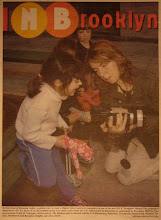 Last week, PS 27 in Red Hook was graced with the presence of the lengendary teacher and writer Vivian Gussin Paley, author of 12 books on childhood and recipient of numerous awards, such as the MacArthur Fellowship. We had a wonderful day with Vivian, who entertained teachers' questions in an informal lunch discussion, provided a Storytelling/Story Acting workshop for the Early Kindergarten class (Shariffa Martinez and Andrew DeMers, teachers), took questions afterwards, went on a walking tour of Red Hook with teachers and students from the neighborhood, and gave a keynote address in the auditorium to a crowd of around 150 people. I felt so honored to experience Vivian working with the same teachers and students I have been collaborating with over the past three years in the school. It was a day none of us in Brooklyn will ever forget.
Last week, PS 27 in Red Hook was graced with the presence of the lengendary teacher and writer Vivian Gussin Paley, author of 12 books on childhood and recipient of numerous awards, such as the MacArthur Fellowship. We had a wonderful day with Vivian, who entertained teachers' questions in an informal lunch discussion, provided a Storytelling/Story Acting workshop for the Early Kindergarten class (Shariffa Martinez and Andrew DeMers, teachers), took questions afterwards, went on a walking tour of Red Hook with teachers and students from the neighborhood, and gave a keynote address in the auditorium to a crowd of around 150 people. I felt so honored to experience Vivian working with the same teachers and students I have been collaborating with over the past three years in the school. It was a day none of us in Brooklyn will ever forget.Here is a highlight from the teachers' discussion with Vivian:
My first approach, in terms of using play as a starting point for whatever kind of lesson you want to teach, is very literal. That is, to put it briefly, you listen always, notebook in hand, you listen for a piece of play, a piece of dialog, or a piece of action. Now you’ve got something concrete. Now, a subject comes up, and here’s where the artful nature of teaching comes in. You say something like, “I heard Jeremy say this, before, on the playground, and it made me think of this. Can we act out what Jeremy was doing?” And bring in your math, your science, ...now this is just the first step….to show how vitally interested you are in every child’s exact language, exact interests, in other words, we’re not speaking of play in general, play in the abstract. We’re not discussing how to improve your golf, in general, we’re actually dis
 cussing things children have said, pretended to be. It’s a kind of game we play, that the teacher can play. Because the question is, how can I bring it in? Don’t think that the child will say to you, as adults often say to the child, “Well, how is that relevant? Why are you telling us about your Aunt Suzie’s canary, when we’re talking about. . .” Because the child thinks anything anyone says is relevant. Or why would they have said it? They have something on their minds that makes them think of, you know: "I was wondering when I heard you play, if the Ninja had to count out how many balls were in the air. . ."or whatever. We want the connection; it’s not phony. It shows, in fact, how logical thinking can progress. The logic here being, "I want your conversation to become part of ours." Think of play being a conversation. That’s what it is: it's a conversation. After that, I would simply say, become, yourself, a storyteller. That also binds together a disparate group, in all these subjects, being 4 to 7 is no problem. Being 4 to 11 would be no problem. These are the universal things children care about. Stories, make believe, and how what I’m thinking connects to what my teacher wants to tell. It’s the best classroom conversation.
cussing things children have said, pretended to be. It’s a kind of game we play, that the teacher can play. Because the question is, how can I bring it in? Don’t think that the child will say to you, as adults often say to the child, “Well, how is that relevant? Why are you telling us about your Aunt Suzie’s canary, when we’re talking about. . .” Because the child thinks anything anyone says is relevant. Or why would they have said it? They have something on their minds that makes them think of, you know: "I was wondering when I heard you play, if the Ninja had to count out how many balls were in the air. . ."or whatever. We want the connection; it’s not phony. It shows, in fact, how logical thinking can progress. The logic here being, "I want your conversation to become part of ours." Think of play being a conversation. That’s what it is: it's a conversation. After that, I would simply say, become, yourself, a storyteller. That also binds together a disparate group, in all these subjects, being 4 to 7 is no problem. Being 4 to 11 would be no problem. These are the universal things children care about. Stories, make believe, and how what I’m thinking connects to what my teacher wants to tell. It’s the best classroom conversation.
